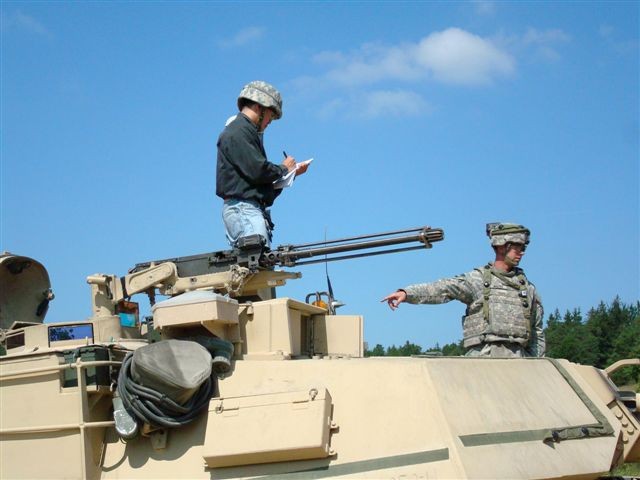PICATINNY ARSENAL, N.J. -- Three Picatinny engineers traveled to Germany for the fourth-phase of military greening in early September.
"Greening" helps engineers who design products for service members to better understand the purpose of why they are designing that specific product.
Picatinny's greening program consists of the new employee orientation, one week at the tactics and weapons employment course here, known as TWEC, a four-day exercise, most commonly at Fort Benning, Ga., for small arms live-fire exercises, known as HOTEX, and two weeks in the field with a Brigade Combat Team.
The third and fourth phases can vary depending on job description. In the third phase instead of the HOTEX, an engineer may go to Fort Leonard Wood, Mo., for demolitions live-fire, Fort Sill, Okla., for artillery live-fire, Fort Bragg, N.C., for breaching close quarter battle or Fort Knox, Ky., for armor live-fire.
Michael Mongiovi, Stephen McFarlane and Wei-Jen Su represented Picatinny product development for two weeks while imbedded with the 172nd Brigade Combat Team in Hohenfels, Germany, during the unit's final pre-deployment training.
Su, an aerospace engineer for the Munitions Engineering and Technology Directorate here, said that "this opportunity allowed use to meet or document the needs of the warfighter through a wide variety of hands-on and educationally instructive activities."
During the visit the engineers witnessed Soldiers training with the Multiple Integrated Laser Engagement Systems, known as MILES. T
he system is a high-end version of laser-tag that allows Soldiers to use their own weapons with the addition of a laser and blank-firing adapter.
The MILES training was "of great benefit to us engineers because one of the Army's creeds is 'train as we fight,' so we were able to observe how Soldiers in combat-like scenarios use the weapon systems that we work to improve," McFarlane said.
McFarlane is a mechanical engineer who works on small caliber munitions for the Mounted and Dismounted Infantry Munitions division here.
A mock-Iraqi town was created for the training assault, which not only included the engineers and American Soldiers, but also members of the British and German Armies as well.
Mongiovi, a systems engineer for the Demilitarization and Environmental Technology Division here, said the scenario was made as realistic as possible.
"They even brought in Iraqi civilians and foreign translators to help train the Soldiers."
This final stage of greening benefits both the engineer and the Soldier because the two can interact cohesively, which could save the Army a lot of money in the research and developmental phases of designing products.
By putting an engineer in a training environment he or she can witness first-hand the problems Soldiers go through in various environments, which could potentially cut down production time and error in development.
Su said this visit will definitely have an impact on future projects.
"Just this week I was involved with a design team for a new projectile and immediately was able to point out a possible flaw in the design based on my understanding of what the Soldier would actually do with the item in the field," he said.
Mongiovi said that initially the Soldiers were unsure why he and the others were there. The engineers sensed some timidity at first because the Soldiers were not sure how to report problems with their equipment and even if they did, the problems were not readily addressed.
Su said, "When a Soldier is willing to talk about their equipment problems, they don't know who to contact. One of the Soldiers I met said that he complained about equipment problems for a long time and this was the first time that somebody showed up to talk about it."
Once the two sides opened up to each other, friendships were formed and business was conducted. The group met a Humvee driver who survived nine improvised explosive device attacks as well as three gun shots.
Because products like Picatinny's Gunner Protection Kit are being designed and Soldiers are providing input for these designs, adaptations to these products are helping to save lives.
When comparing the visit to previous phases of greening, McFarlane said, "TWEC and HOTEX were great training opportunities, however they don't compare to the pre-deployment training we were able to witness in Germany.
We were given the opportunity to interact with our number one customer, the Soldier."
McFarlane added, "Every engineer (who) works for the U.S. Army should be given the opportunity to witness pre-deployment training."
When not in the field, the three engineers were able to tour the countryside and revel in the culture of the land while visiting various castles and historic landmarks and tasting Bavarian foods and drink.




Social Sharing